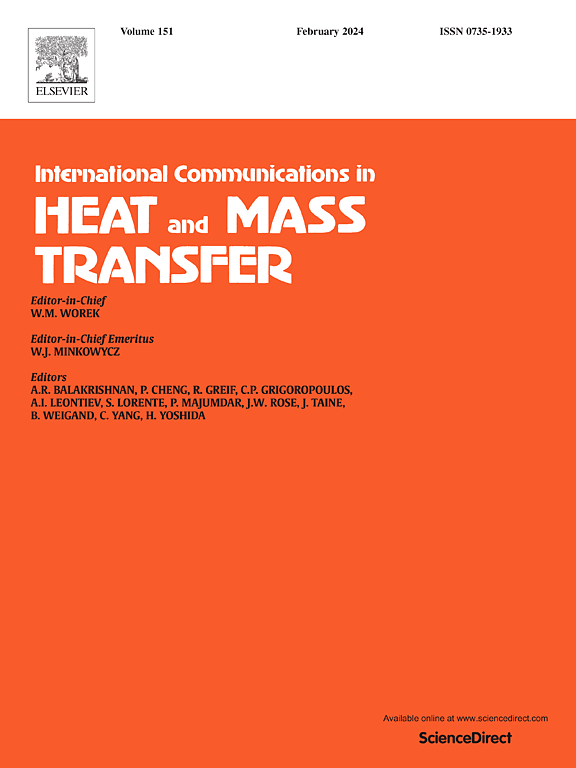Optimization design and heat transfer investigation of TPMS compact heat exchanger based on field synergy principle
IF 6.4
2区 工程技术
Q1 MECHANICS
International Communications in Heat and Mass Transfer
Pub Date : 2025-05-09
DOI:10.1016/j.icheatmasstransfer.2025.109003
引用次数: 0
Abstract
The rapid development of additive manufacturing (AM) has made it possible to produce compact heat exchangers with triply periodic minimal surface (TPMS) structures. However, although original TPMS type heat exchangers offer the advantages of both porous and biomimetic structures, there is still room for optimization in terms of compactness and efficiency. This study designed a G-D type TPMS heat exchanger based on the field synergy principle, combining the advantages of two fundamental TPMS structures (Gyroid and Diamond) to enhance fluid velocity and temperature gradient synergy throughout the heat exchanger, thus strengthening heat transfer. A prototype G-D heat exchanger was successfully fabricated using 3D printing technology and characterized by CT imaging. Computational fluid dynamics (CFD) simulations and experiments were conducted to compare the flow and heat transfer performance of the G-D heat exchanger with that of the original TPMS heat type exchanger. Flow and heat transfer correlations for the G-D heat exchanger were derived using the least-squares fitting method. The dimensionless factor j/f1/3 was used to evaluate the overall performance of the heat exchanger. Results showed that the G-D heat exchanger exhibited significantly improved heat transfer efficiency and compactness compared to traditional and original TPMS type heat exchangers, with a heat transfer rate per unit volume of 604.4 W/cm3 under a temperature difference of 40 °C. This study offers valuable guidance for the fusion of different TPMS structures and the design of efficient, compact heat exchangers.
基于场协同原理的TPMS紧凑型换热器优化设计及传热研究
增材制造技术(AM)的快速发展使得具有三周期最小表面(TPMS)结构的紧凑型换热器的生产成为可能。然而,尽管原始的TPMS型热交换器具有多孔和仿生结构的优点,但在紧凑性和效率方面仍有优化的空间。本研究设计了一种基于场协同原理的G-D型TPMS换热器,结合两种TPMS基本结构(Gyroid和Diamond)的优点,在整个换热器中增强流体速度和温度梯度的协同作用,从而加强传热。利用3D打印技术成功制造了一个G-D热交换器原型,并通过CT成像进行了表征。通过计算流体力学(CFD)模拟和实验,比较了G-D换热器与原TPMS换热器的流动和换热性能。采用最小二乘拟合方法,推导了G-D换热器的流动和传热相关性。采用无量纲因子j/f1/3评价换热器的综合性能。结果表明,在温差为40℃时,G-D换热器的单位体积换热率为604.4 W/cm3,与传统的TPMS换热器和原TPMS换热器相比,换热效率和紧凑性均有显著提高。该研究为不同TPMS结构的融合和高效紧凑换热器的设计提供了有价值的指导。
本文章由计算机程序翻译,如有差异,请以英文原文为准。
求助全文
约1分钟内获得全文
求助全文
来源期刊
CiteScore
11.00
自引率
10.00%
发文量
648
审稿时长
32 days
期刊介绍:
International Communications in Heat and Mass Transfer serves as a world forum for the rapid dissemination of new ideas, new measurement techniques, preliminary findings of ongoing investigations, discussions, and criticisms in the field of heat and mass transfer. Two types of manuscript will be considered for publication: communications (short reports of new work or discussions of work which has already been published) and summaries (abstracts of reports, theses or manuscripts which are too long for publication in full). Together with its companion publication, International Journal of Heat and Mass Transfer, with which it shares the same Board of Editors, this journal is read by research workers and engineers throughout the world.

 求助内容:
求助内容: 应助结果提醒方式:
应助结果提醒方式:


